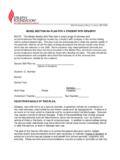Transcription of epilepsy and swimming - MREA
1 IntroductionThis information was originally prepared by the National Co-ordinating Committee on swimming for the Disabled. The Mersey Region epilepsy Association is grateful to it for their permission to people with epilepsy go swimming ?For the sake of their own safety, people should learn to swim. People with epilepsy , and especially children, are subjected to all sorts of restrictions and it is particularly valuable for a sport like swimming to remain open to them. Some children with epilepsy have poor co-ordination, which makes many sports difficult, so swimming is of even greater benefit to is much safer for people with epilepsy to swim with their condition known about and, if they are banned, many of them will continue to swim without disclosing it, to the possible danger of themselves and others.
2 However, there are potential risks for all those liable to is desirable to encourage a relationship of trust between Baths Management and people with epilepsy . If the latter know that they will not be turned away on account of their handicap, they will be more likely to reveal it and this is really in the interests of all Association has always advised people with epilepsy , and especially parents of children with epilepsy , to seek their GP s approval for swimming , and in this connection the following considerations should be taken into account: What is the degree of control?
3 Is there any warning? Does the patient stop actions, or repeat actions automatically? Are there any triggering factors which might occur while swimming , cold water, stress and/or excitement of competitive events, noise of crowded pool, dazzling lights on water surface, etc?How dangerous is a seizure in the water?Under controlled conditions it is minimal. Fatal or even serious accidents are rare, but have been known to occur. Studies in Australia and Hawaii show the absolute risk of drowning as a result of an epileptic seizure is low, though children and adults who are also mentally or physically disabled - are at greater risk.
4 Good baths management, however, should reduce this risk can swimming be made safe for people with epilepsy ?By recognising the problem. Allow them to swim only if accompanied by a responsible companion, someone who is a strong and capable swimmer (and preferably is a qualified life-saver). The companion should also be able to recognise a seizure immediately it starts and must be physically capable of supporting the person he is responsible for in deep water, or the bather should be restricted to the helper s standing Region epilepsy AssociationRegistered Charity Number: 404366epilepsy and swimmingHow can a seizure be recognised in the water?
5 Watch for loss of co-ordinated movement. Some people with epilepsy continue the activity they were performing in the early stages of the attack, but their stroke becomes uncoordinated and starts to break up. Direction becomes vague and involuntary head movements may can a seizure be dealt with?First priority is to keep the face above water, and it is best to approach the swimmer from behind. If it is possible, tow him to shallow water and hold his head until the attack passes. He will do less damage to himself in water than on land if his breathing is , after the convulsion is over, the swimmer should be removed from the pool side.
6 If breathing has stopped, normal resuscitation measures should be taken. Close surveillance of someone liable to tonic-clonic seizures is especially necessary, and familiarity with the particular type of seizure is obviously desirable on the part of the companion. Absence seizures are brief, but the swimmer may suddenly sink. Staff should be familiar with first aid measures in case of tonic clonic medical assistance necessary?No, provided resuscitation is not required, there is no injury and one seizure does not follow another without the person regaining consciousness in between (status epilepticus).
7 This is rare, but when it does occur it is a medical emergency and help should be summoned POINTS1 It is interesting to note that very few seizures occur in the Somebody should be watching both the person with epilepsy and the companion. If the latter cannot life-save, this is even more important, unless both are restricted to the helper s depth, as recommended In some circumstances it may be better for the companion to remain on the pool side, as he will have a clearer view and may be able to reach a person more quickly, unless he remains very close at Two useful points for people with epilepsy to observe are: - to avoid swimming when feeling unwell.
8 - to choose a quiet time in the pool and avoid, where possible, those periods such as weekends and bank holidays when there are likely to be crowds. It is worth remembering that many swimming pools have special sessions for those with disability, but because of the stigma attached to epilepsy and the reluctance of many people to admit to it publicly, it is difficult to ensure that everyone with epilepsy uses public swimming pools in these If the swimmer can be persuaded to wear a brightly coloured swimming cap, this should be encouraged.
9 But again one cannot help feeling that many adults would not be willing to draw attention to themselves in this FOR SCHOOLSG oing swimming at school means that the child must be observed on a one-to-one basis, and it may therefore not be possible, unless a parent who can swim accompanies the child and observes from the side of the Association advocates the adoption of the pairing system - known as the buddy system in the USA. If, in any swimming session, all children were expected to swim in pairs it would provide additional safety for weaker swimmers and for children with epilepsy .
10 In the latter case it would have the advantage of not drawing attention to their condition because the procedure would be benefits of the system are many. It enables life-saving to be taught in pairs and encourages an awareness of the safety of others while developing confidence in the less is customary in the USA to use the system at summer camp and on school holidays, as well as for conventional class sessions. A whistle is blown once or twice during the session and swimmers must be able to touch each other immediately. Failure is penalised by forfeiting the rest of the session or the following Association would welcome the introduction of the scheme into all schools and would be pleased to send staff to assist its implementation with general leaflet is mainly concerned with swimming in indoor public swimming pools.






